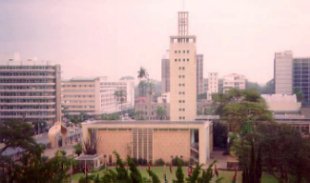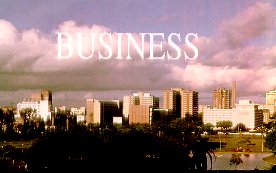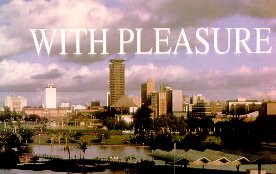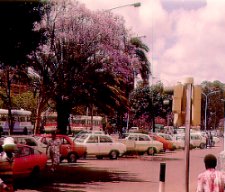


NAIROBI is a modern city in every sense of the world. Until the late 1800s, it was simply a swampy area that boasted the odd Maasai encampment. Now, with a population of more than a million, it is the largest city in Africa between Cairo and Johannesburg and undoubtedly one of the most pleasant and popular urban centres in the whole continent.
Its tower blocks can be seen for miles around and pan-African and international businessmen flock here in the sure knowledge that, in Nairobi, the telecommunications will work, the mail will reach its destination and the infrastructure will not fall apart overnight - things that cannot necessarily be assured elsewhere in Africa. Moreover, even if there is a traffic jam, you can walk quite comfortably from one end of the central business district to the other in just 20 minutes.
That Nairobi exists at all is pure chance. Towards the end of the last century, the colonial powers of Britain and Germany were locked in a battle to control as much of Africa as possible. By 1895, the British had secured the administration of the "East African Protectorate" and had set up their headquarters in the historic coastal city of Mombassa.
The race was now to secure Uganda and the British decided to build a railway, subsequently dubbed the "Lunatic Line", that was to run from Mombassa, 935 km through largely uncharted territory, to Lake Victoria. The first 500 odd km from Mombassa - in spite of the intense heat of the Taru Desert and the unwanted attention of two lions, "the Man Eaters of Tsavo", who developed a taste for indentured labourers and railway engineers - was relatively easy going. The land rose gently from the coast until it reached the base of the escarpment on the southern approaches of the Abendares or Nyandarno Range. By May 1899, the railway had reached this area. At Mile Peg 317, roughly half way between Mombassa and Uganda, it was decided to set up a base camp so that the engineers could live near the trouble spots of the higher land to come.
A tented camp was erected by a small river called Enairobe ("cool
waters") by Maasai. Although largely foul-smelling swamp,
the site offered a flat area for marshaling yards and, slightly
higher, breeze-cooled ground for staff housing. The tents soon
gave way to a ramshackle collection of wooden houses. The lucky
few lived in the ones on stilts that offered some protection from
the long rains, which turned dirt roads into quagmires, and some
respite from the armies of white ants which plagued every other
living creature.

City view of Nairobi.
The rapidly expanding township was regarded by skeptics on the coast as a white elephant, relevant to the rest of the country only as long as the railway was in construction: but in the wake of the working railway came farmers and white hunters, commerce and industry. The higher land proved to be some of the most fertile in Kenya, game still roamed the surrounding plains attracting the rich and famous, including the then Prince of Wales and Theodore Roosevelt; and Nairobi was, after all, geographically at the very heart of an increasingly dynamic country.
By 1905, Nairobi had become the natural choice as the capital of the Protectorate, luring not only administrators and ambassadors, but the businessmen and entrepreneurs who had previously remained loyal to Mombasa. There were still some minor problems - the flat land that had been ideal for marshaling yards was a thick and impervious kind of soil known as "black cotton". It proved, and to some extent still proves, a nightmare for architects and drainage experts.
Problems with the physical foundations of the rapidly city could not, however, hold it back; but they do to some extent explain why there are relatively few of the original buildings extant in Nairobi today. The generously wide, treelined streets remain, however, and the trees themselves do date back to Nairobi's earliest days. When the town was being planned and built, none of the British had a thorough knowledge of Kenya's own indigenous trees.
The horticultural experts' solution was to send to the far corners of the empire for trees that they knew would survive the climate and provide shade, colour and scent in plenty. Thus you will find blue gum, grevillea and wattle from Australia, and jacaranda from South America, all now so well established that few recognise them as imports.
The early planners had done a good job and, though there are now new, pleasant and sprawling suburbs, the modern business visitor benefits from the original, compact city centre. This area of approximately one square kilometre is easily recognisable and bounded by Uhuru Highway, Haile Selassie Avenue, Tom Mboya Street and University Way. Here you will find almost all the major corporate offices, the post office, banks and, of course, the jewel in Nairobi's commercial and diplomatic crown, the Kenyatta Conference Centre.
A fitting memorial to the great Mzee Jomo Kenyatta, who led Kenya into independence, this outstanding piece of modern architecture has been the venue for countless international and pan-African meetings of historic importance. With all the modern facilities to cater for large delegations of up to 4000 people, the centre has the added benefit of a viewing platform on the 24th floor which offers unsurpassed views of the city and its surrounds. Another benefit is that it is a very short walk from the Hotel Inter-Continental Nairobi, where VIPs around the world frequently choose to stay, entertain their guests and conduct private meetings.
Hotel Inter-Continental Nairobi naturally has comprehensive business
facilities and is well used to looking after the needs of the
business traveler. Its own conference rooms can accommodate up
to 800 people and there are plenty of smaller rooms for more intimate
gatherings. Kenyans enjoy the social side of international business
and the Hotel Inter-Continental Nairobi is a favourite rendezvous.

Wide, tree-lined streets, a legacy of the original city planners, give Nairobi a sense of space.
As we have mentioned before, almost all appointments in the city can be reached on foot, although you may prefer to take a short taxi ride to the diplomatic centre perched up on the hill overlooking the city or to the main industrial area. Taxis cannot be hailed in the street as they do not cruise for business, but there are ranks outside almost every hotel, the railway station and other prominent site. Fares are remarkably reasonable, and generally uniform within the city. They are not, however, metered, so always establish a price before you set out on a journey of any great distance. There are morning and afternoon rush hours, which tend to include noisy and colourful traffic jams, but to anyone who has experienced trying to cross London or New York during the rush, they will seem like very small hold-ups indeed.
Road, rail and air connections with Nairobi are excellent and although the Travel Desk at the Hotel Inter-Continental Nairobi will be more than happy to make all your business and leisure arrangements, if you wish to book independently, the major international airlines and a number of well-established safari companies have offices in the main city area.
With so little time wasted during the day getting from A to B, first time business travelers to Nairobi are pleasantly surprised to find that there is almost always the opportunity to take little time out. This is a friendly, lively, cosmopolitan city, with museums, nightclubs, casinos, concerts and cinemas a plenty, plus a selection of restaurants that offer all the great cuisine's of the world.
Shopping is a positive joy. A spree might start in the craft shops of Standard Street of Kenyatta Avenue where traditional carved artifacts made out of soapstone and ebony can be found that would grace any boardroom or living room. Tie-dyed cloth and traditional jewelry are also a perennial favourite.
The Kenyan fashion industry has come a long way since the days
when you could have any color you wanted as long as it was khaki
and the most popular accessory was an elephant gun. Companies
such as African Heritage export their sophisticated interpretations
of traditional dress, gleaned from around the continent, to the
smart stores of the major cities of the world; but the choice,
and the price advantage, of buying such clothes here is a great
temptation. Kenya also has a well developed gems industry that
there are some fine stones, cut or uncut, loose or set, to be
had including particularly attractive tanzanite and tourmalines.

The view towards the city from Nairobi Park, home to a rich variety of wildife.
Arguably Nairobi's greatest asset, though, is that it is so easy to find room to breathe. Within the city itself, and overlooked by the Hotel Inter-Continental Nairobi, the largest open space , Uhuru Park, is a pleasant place for a stroll. Nairobi also has a whole, huge, well-stocked National Park on its doorstep. Within minutes of your last meeting of the day, and for as long as the light holds, you can escape the asphalt and drive among Nairobi's original inhabitants; elephants, rhino (yes, they are very carefully guarded), lion, ostrich, zebra and more flourish here. Somehow, having a city skyline as a backdrop to a scene of a family of giraffe browsing seems to add to, rather than detract from, an encounter with Africa's wildlife.
It is clear that Nairobi has more to attract the business traveler than air-conditioned efficiency. It is, justifiably, winning a lion's share of the recent rush of pan-African meetings generated by the end of apartheid in South Africa. For purely geographical reasons, it is the ideal compromise rendezvous between Europe, the middle East and Johannesburg. /for many other reasons it is the venue that most business people can happily be persuaded to return to time and time again.
 SAFARI places to visit...
SAFARI places to visit...
 go back
go back